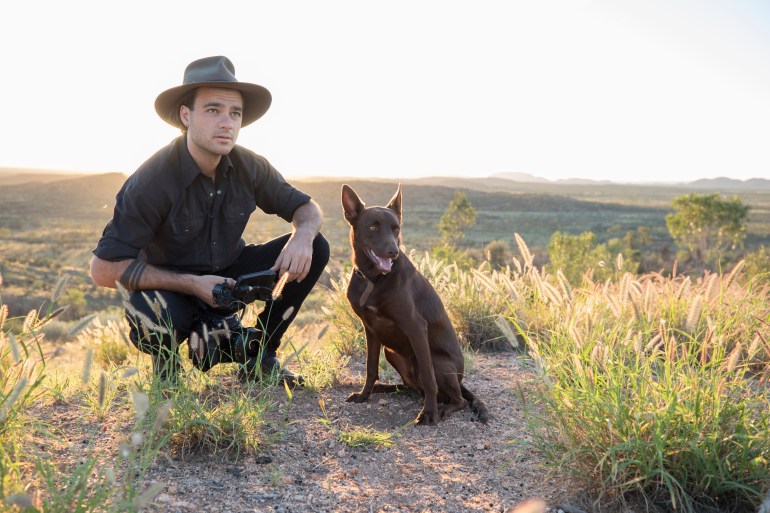Dylan River in ‘Tales by Light’.
When Tales By Light director/producer Abraham Joffe first got in contact with Indigenous director and cinematographer Dylan River to ask if he would be involved with the show, River initially thought he wanted him to shoot it.
However, the Tales By Light team wanted River in front of the camera; he is the subject of one of the episodes of season three, which launched on Netflix Australia this week after a run on Network 10 last year.
Tales By Light, backed by Canon Australia, profiles photographers. In addition to River, season three includes Simon Lister, who goes to Dhaka, Bangladesh with UNICEF Goodwill Ambassador Orlando Bloom to capture the lives of children residing in slums, and conservationist Shawn Heinrichs who travels to Mexico and Indonesia to share footage of human impact on marine life in our oceans.
While being in front of the camera was weird initially, River saw an opportunity to create something that is authentic to who he is and what he does. It was clear from the start that his episode would cover Aboriginal Australia and in some way, his family.
Filmmaking is in River’s genes: he’s the son of director/DOP Warwick Thornton and producer Penelope McDonald. His grandmother is Freda Glynn, co-founder of the Central Australian Aboriginal Media Association (CAAMA), his aunt is director Erica Glynn, and River runs a production company – Since 1788 Productions – with cousin Tanith Glynn-Maloney.
It was a conversation about the legacy of his grandmother in establishing CAAMA that helped drive the episode’s direction.
“I talked about how CAAMA has this massive archive of old tapes and stuff that’s been recorded over the years, and how important this archive is for Aboriginal people – a lot of the stories, songs, language and stuff on there has been lost now. We talked about loss of language, loss of culture and the idea of recording and documenting, and how important that is.”
River’s episode sees him visit the central desert near Alice Springs, Victoria River on the norther edge of the Tanami Desert and the remote Yolngu community in Bawaka East Arnhem Land. In each place, he meets up with people he knows and asks them what they would like him to record for them.
The filmmaker hopes people take away a message about the role we can all play in recording our own histories. “Besides that, there’s the bigger picture of Aboriginal Australia and the state of culture in this country; how beautiful it can be, and how many more Australians and the world could learn from it. Especially in a time of issues of global warming and things like that. I think the connection to country and the things that you find inside Aboriginal culture are the simplicities in life which we can all gain from to make this a better world.”
At this stage of his career, River says he is still into trying new things – whether that be music videos, photography, documentaries and web series. His debut documentary Buckskin won the Australian Documentary Prize at Sydney Film Festival in 2013, and his first short film Nulla Nulla screened in Berlin and Toronto in 2015, and won the AACTA Award for Best Short Fiction Film. His most recent documentary Finke: There and Back screened in various festivals around Australia, and River helped Thornton shoot Sweet Country and documentary We Don’t Need A Map.
He is currently working on 6 x 10 minute web series for kids, Robbie Hood, for SBS. It’s a retelling of Robin Hood but set in Alice Springs, following a 13 year old boy Robbie.
“It’s all the connotations of the folk tale; he steals from the rich to give to the poor, and basically tries to correct injustices he sees in his community. It’s a bit of fun.”
Growing up in a filmmaking family meant River never saw a career in the screen industry as a “wild, absurd” thing, and notes he has benefited from knowing how the processes of the industry work.
“But then my family taught from a very young age that if you’re going to tell a story: have something to say. That is the most important part of the whole process. That’s something I definitely think about every time I’m approaching a new project or idea: What am I saying, what’s this about, and why is it important? Has this been done before or is this new?”
The landscape for young Indigenous filmmakers is easier today thanks to the people who went before, River says.
“My grandmother had to fight very hard to start CAAMA and my dad had to fight hard to get his first few projects up, and at the same time, there’s been a lot of other people fighting, campaigning and building what has now become quite an established industry within an industry.
“All this stuff has grown to allow me and other young filmmakers to step in and have it a lot easier. But in saying that, the work’s not done. It’s now our job to uphold that, continue making quality work, taking every opportunity and making the most of it.”


